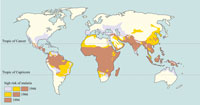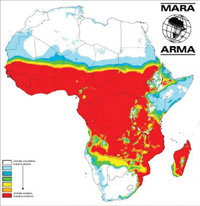5.1 The burden of malaria
Malaria is one of the most serious diseases to affect people in developing countries with tropical and subtropical climates. It is particularly dangerous for young children and for pregnant women and their unborn babies, although others may also be seriously affected in some circumstances. Malaria is endemic in 109 countries and more than three billion of the world’s population lives in malaria risk regions. Globally, 300–500 million episodes of malaria illness occur each year, resulting in over one million deaths. As Figure 5.1 shows, changes in socio-economic conditions and anti-malaria interventions have gradually reduced the areas of the world where malaria is endemic, but it is still widespread as a major global disease. A communicable disease is said to be endemic in a region or country if it is always present there. In areas where many cases occur throughout the year, the disease is said to be highly endemic, or (to say it another way) it has high endemicity.
Endemic is pronounced 'end-em-ik', and endemicity is pronounced 'end-em-iss-it-ee'.

More than 90% of the worldwide deaths from malaria occur in sub-Saharan Africa and most of these deaths are in children. Malaria risk is highest in tropical Africa where conditions (which will be considered further below) are very favourable for malaria transmission (Figure 5.2).
Look at Figure 5.2 and describe what it shows about the incidence of malaria in Africa.
Figure 5.2 shows that the highest incidence of malaria (as shown in red) is around the equator and in the tropics. Malaria is much less common in the northern and southern part of the continent.
The intricate interactions between host, parasite, vector and the environment are the major factors in the distribution of malaria. Different areas can experience different levels of incidence rates.
Malaria can be viewed in terms of being stable or unstable. Malaria is said to be stable (and therefore endemic) when malaria infections occur for many months in a year, over many years. People living in highly endemic areas usually exhibit a high level of immunity and tolerate the infection well. Immunity against malaria is the ability to fight the infection, which is developed by people with repeated episodes of malaria. Under endemic conditions, children under the age of five years, and pregnant mothers, are most likely to be infected as they have weaker immunity.
Unstable (epidemic) malaria refers to a seasonal type of transmission seen in areas of low endemicity, or to outbreaks in areas previously without malaria, or among non-immune persons. Epidemics can be due to changes in human behaviour, environmental and climate factors. For example, human migration and resettlement can introduce malaria into an area that did not have it previously, and this can expose a population to the disease that was not immune to malaria. Malaria epidemics generally occur when the population in an area has weak immunity to the disease, because so many people in the population will be vulnerable to malaria, not just children under five years of age and pregnant women.
However, it is important to remember that children and mothers are always more at risk, so they will need particular attention.
Learning Outcomes for Study Session 5

